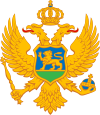Montenegrins in Germany
Appearance
 Distribution of Montenegrin citizens in Germany (2021) | |
| Total population | |
|---|---|
| 30,000 [1] | |
| Languages | |
| German, Montenegrin | |
| Religion | |
| Montenegrin Orthodox, Roman Catholic, Muslim and Jewish minority | |
| Related ethnic groups | |
| Montenegrins, Montenegrins in France, Montenegrins in Switzerland, Montenegrins in Luxembourg, Montenegrins in the Netherlands, Montenegrins in Sweden |
Montenegrins living in Germany (German: Montenegriner in Deutschland) are supported and represented by various associations.[2] They number around 30,000. Some Montenegrins immigrated during the 1960s and 1970s as Gastarbeiter ("guest workers") when Montenegro was still a part of Yugoslavia. A minority arrived as refugees during the Yugoslav Wars in the 1990s.
Some Montenegrins still want to migrate to Germany, especially from the northern parts of Montenegro. In 2015, approximately 6,000 attempted to travel into Germany to seek asylum but were unsuccessful.[3][4] In 2016, 683 Montenegrins were granted work permits. In 2017, this number rose to 876.[5] In 2018, Germany made it easier for Montenegrins to gain a work permit.
| Part of a series on |
| Montenegrins |
|---|
 |
| By region or country |
| Recognized populations |
|
Montenegro Serbia Bosnia and Herzegovina Croatia North Macedonia Kosovo Albania |
| Diaspora |
|
|
|
|
| Culture |
|
| Religion |
|
Catholicism Islam |
| Language and dialects |
| History |
|
History of Montenegro Rulers |
See also
[edit]References
[edit]- ^ "Van granica živi oko 500,000 Crnogoraca". Pobjeda. RTCG. Retrieved 28 January 2018.
- ^ "NjEMAČKA: Odlično sarađujemo sa Crnom Gorom". Montenegro EAA. Retrieved 30 November 2009.
- ^ "Građanima CG odbijen azil u Njemačkoj". Al Jazeera. Retrieved 22 November 2015.
- ^ "Crnogorci masovno migriraju: Put u azil izlaz iz nemaštine". Radio Slobodna Evropa. Retrieved 11 March 2015.
- ^ "Šansa za građane Crne Gore: Lakše do posla u Njemačkoj". Caffe del Montenegro. Retrieved 8 March 2018.

